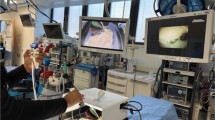Abstract
Background
Laparoscopic common bile duct exploration (LCBDE) is an underutilized therapy for choledocholithiasis. The driving factors of this practice gap are poorly defined. We sought to evaluate the attitudes and practice patterns of surgeons who underwent training courses using an LCBDE simulator.
Methods
Surgeons completed a half-day simulator-based LCBDE curriculum at national courses, including the American College of Surgeons Advanced Skills Training for Rural Surgeons and the Society of American Gastrointestinal and Endoscopic Surgeons annual meeting. Attitudes were assessed with Likert surveys immediately before and after curriculum completion. Follow-up surveys were distributed electronically.
Results
159 surgeons completed training during six courses. Surgeon attitudes regarding the overall superiority of LCBDE vs. ERCP shifted towards favoring LCBDE after course participation (4.0 vs 3.3; Likert scale 1–5, p < 0.001). 44% of surgeons completed follow-up surveys at a mean of 3 years post-course. Surgeons remained confident in their ability to perform LCBDE, with only 14% rating their skill as a significant barrier to practice, as compared with 43% prior to course participation (p < 0.01). However, only 28% of surgeons saw an increase in LCBDE volume. Deficiencies in operating room (OR) staff knowledge and instrument availability were the most significant barriers to post-course practice implementation and were inversely correlated with LCBDE case volume (ρ = − 0.44 and − 0.47, both p < 0.01). Surgeons for whom OR staff knowledge of LCBDE was not a significant barrier performed nearly 4 times more LCBDE than those who rated staff knowledge as a moderate, strong, or complete barrier.
Conclusions
Surgeons trained at an LCBDE course retained long-term confidence in their procedural ability. Practice implementation was hindered by deficiencies in OR staff knowledge and instrument availability. Surgeons with knowledgeable operating room staff performed significantly more LCBDEs than those with less capable assistance. These barriers should be addressed in future curricula to improve procedural adoption.



Similar content being viewed by others
References
Baiu I, Hawn MT (2018) Choledocholithiasis. JAMA 320:1506
Singh AN, Kilambi R (2018) Single-stage laparoscopic common bile duct exploration and cholecystectomy versus two-stage endoscopic stone extraction followed by laparoscopic cholecystectomy for patients with gallbladder stones with common bile duct stones: systematic review and meta-analysis of randomized trials with trial sequential analysis. Surg Endosc 32:3763–3776
Lyu Y, Cheng Y, Li T, Cheng B, Jin X (2018) Laparoscopic common bile duct exploration plus cholecystectomy versus endoscopic retrograde cholangiopancreatography plus laparoscopic cholecystectomy for cholecystocholedocholithiasis: a meta-analysis. Surg Endosc 33:3275–3286
Schwab B, Teitelbaum EN, Barsuk JH, Soper NJ, Hungness ES (2018) Single-stage laparoscopic management of choledocholithiasis: an analysis after implementation of a mastery learning resident curriculum. Surgery 163:503–508
Guan G, Sun C, Ren Y, Zhao Z, Ning S (2018) Comparing a single-staged laparoscopic cholecystectomy with common bile duct exploration versus a two-staged endoscopic sphincterotomy followed by laparoscopic cholecystectomy. Surgery 164:1030–1034
Wandling MW, Hungness ES, Pavey ES, Stulberg JJ, Schwab B, Yang AD, Shapiro MB, Bilimoria KY, Ko CY, Nathens AB (2016) Nationwide assessment of trends in choledocholithiasis management in the United States from 1998 to 2013. JAMA surgery 151:1125–1130
Santos BF, Reif TJ, Soper NJ, Nagle AP, Rooney DM, Hungness ES (2012) Development and evaluation of a laparoscopic common bile duct exploration simulator and procedural rating scale. Surg Endosc 26:2403–2415
Teitelbaum EN, Soper NJ, Santos BF, Rooney DM, Patel P, Nagle AP, Hungness ES (2014) A simulator-based resident curriculum for laparoscopic common bile duct exploration. Surgery 156(4):880–893
Halverson AL, Andersson JL, Anderson K, Lombardo J, Park CS, Rademaker AW, Moorman DW (2009) Surgical team training: the Northwestern Memorial Hospital experience. Arch Surg 144:107–112
Robertson JM, Dias RD, Yule S, Smink DS (2017) Operating room team training with simulation: a systematic review. J Laparoendosc Adv Surg Tech A 27:475–480
Hamman WR, Beaubien JM, Beaudin-Seiler BM (2009) Simulation for the training of human performance and technical skills: the intersection of how we will train health care professionals in the future. J Grad Med Educ 1:245–252
Sorensen JL, Van der Vleuten C, Lindschou J, Gluud C, Ostergaard D, LeBlanc V, Johansen M, Ekelund K, Albrechtsen CK, Pedersen BW, Kjaergaard H, Weikop P, Ottesen B (2013) 'In situ simulation' versus 'off site simulation' in obstetric emergencies and their effect on knowledge, safety attitudes, team performance, stress, and motivation: study protocol for a randomized controlled trial. Trials 14:220
Rao R, Caskey RC, Owei L, O'Connor K, Riddle E, Dempsey DT, Atkins J, Baranov D, Motuk G, Brooks AD, Williams N, Morris J, Dumon K (2017) Curriculum using the in-situ operating room setting. J Surg Educ 74:e39–e44
Cook MR, Hughes D, Deal SB, Sarap MD, Hughes TG, Deveney KE, Brasel KJ, Alseidi AA (2019) When rural is no longer rural: Demand for subspecialty trained surgeons increases with increasing population of a non-metropolitan area. Am J Surg 218:1022–1027
Funding
Ryan A. J. Campagna, MD is supported by T32DK101363 from the National Institutes of Health.
Author information
Authors and Affiliations
Corresponding author
Ethics declarations
Disclosures
Dr. Santos: Cook Medical—consulting; Boston Scientific—consulting. Dr. Hungness: Cook Medical—consulting; Boston Scientific—consulting. Dr. Teitelbaum: Cook Medical—consulting; Boston Scientific—consulting. Dr. Campagna reports grants from the National Institutes of Health during the conduct of the study. Ms. Belette, Dr. Holmstrom, and Dr. Halverson have nothing to disclose.
Additional information
Publisher's Note
Springer Nature remains neutral with regard to jurisdictional claims in published maps and institutional affiliations.
Electronic supplementary material
Below is the link to the electronic supplementary material.
Rights and permissions
About this article
Cite this article
Campagna, R.A.J., Belette, A.M., Holmstrom, A.L. et al. Addressing the gap in laparoscopic common bile duct exploration training for rural surgeons: imparting procedural ability is not enough. Surg Endosc 35, 5140–5146 (2021). https://doi.org/10.1007/s00464-020-08003-7
Received:
Accepted:
Published:
Issue Date:
DOI: https://doi.org/10.1007/s00464-020-08003-7




